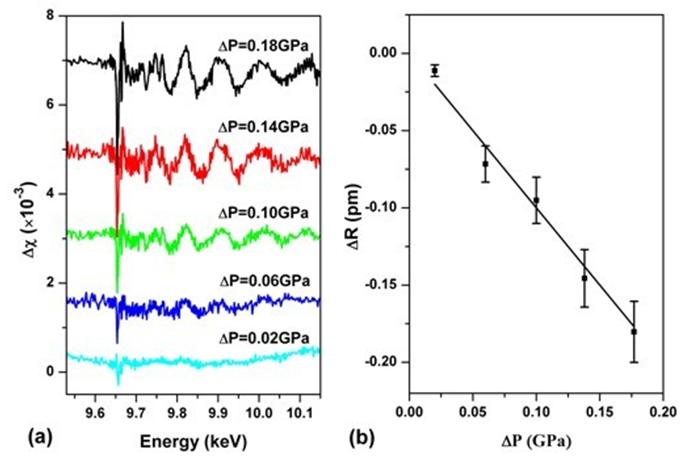| The measurement of differential EXAFS modulated by high pressure |
| From: PublishDate:2012-06-26 Hits: |
The modulation and demodulation technique is the base of radio broadcast, as well as the information transmission and communication of modern computers. In physics, the modulation method has been applied to study the spectroscopy of semiconductors since the 1960s. Modulation spectrum, which is to measure small changes of sample under the periodic perturbation of external fields, can substantially increase the contrast of micro-structures that are difficult to discover on the static spectrum. Due to the unique characteristic of high resolution and high sensitivity, it is drawing more and more attentions. Modulation technique was also been introduced into the experiments of X-ray Absorption Fine Structure (XAFS) at the end of 20th century. The results from the present investigation indicate that modulated XAFS is able to detect femtometer-scale atomic displacements, and shows a sensitivity of 100 times better than conventional EXAFS. We have established a novel experimental technique the pressure-modulated XAFS is firstly established on 1W1B XAFS station, Beijing Synchrotron Radiation Facility (BSRF). The technique is based on the dynamic Diamond Anvil Cell (dDAC). Pressure modulation system is built up on the basis of dDAC equipment. The working principle of the system is that the distance between two diamonds in DAC is controlled by the periodic motion of PZT position, and then the pressure on the sample varies according to the small adjustment of the distance of diamonds, as shown in figure1.
Fig1. (a) Photograph of the dDAC. (b) Several periods of pressure change on ZnSe in a dDAC at 4.8 GPa. Solid squares denote the pressure measured by ruby fluorescence. The dashed line is a periodic 1 Hz ramp wave applied to three actuators. Moreover, we have developed the relatively complete pressure-modulated XAFS technique based on the modulation system of dDAC, from the experimental devices, and measuring method to data analysis. We have detected 0.001Å atomic displacement change by this method, which shows a precision of one order of magnitude better than conventional EXAFS (figure 2).
Fig.2 Zn K-edge DiffEXAFS signal of ZnSe upon various pressure differences. Combining the XAFS, high pressure condition and modulation method, the pressure-modulated XAFS technique unites the characteristic of modulation and the ability of XAFS to probe local structure. The method can in situ study the local structure variation of materials under dynamic high pressure condition, for example to study a pressure-induced phase transition process in detail, or to investigate the difference of dynamic modulation and static process, and so on. Furthermore, the dynamic DAC can be used not only in the measurement of x-ray absorption spectrum, but also in the experiment of diffraction, infrared absorption, raman spectroscopy and so on. Article: Shengqi Chu, Lirong Zheng, Yingli Zhou, Aiyu Zhou, Jing Zhang, Rongzheng Che, Jing Liu and Tiandou Hu*,The measurement of differential EXAFS modulated by high pressure, J Synchrotron Radiat. 2011,18, 728-32. |
|
|
| Chinese
Science Highlights
Home /
Copyright © 2011 - 2012 Beijing Synchrotron Radiation Facility



